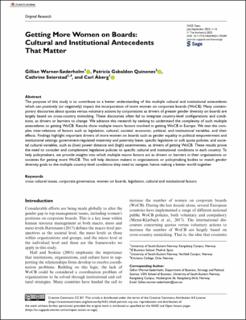| dc.contributor.author | Warner-Søderholm, Gillian | |
| dc.contributor.author | Gabaldón Quiñones, Patricia | |
| dc.contributor.author | Seierstad, Cathrine | |
| dc.contributor.author | Åberg, Carl | |
| dc.date.accessioned | 2024-04-08T08:17:19Z | |
| dc.date.available | 2024-04-08T08:17:19Z | |
| dc.date.created | 2023-08-30T10:37:00Z | |
| dc.date.issued | 2023 | |
| dc.identifier.citation | Sage Open. 2023, 13 (3), 1–16. | en_US |
| dc.identifier.issn | 2158-2440 | |
| dc.identifier.uri | https://hdl.handle.net/11250/3125201 | |
| dc.description.abstract | The purpose of this study is to contribute to a better understanding of the multiple cultural and institutional antecedents which can positively (or negatively) impact the incorporation of more women on corporate boards (WoCB). Many contemporary discourses about quotas versus voluntary actions by corporations as drivers of greater gender diversity on boards are largely based on cross-country mimicking. These discourses often fail to integrate country-level configurations and conditions, as drivers or barriers to change. We advance this research by seeking to understand the complexity of such multiple antecedents to getting WoCB. Results show multiple macro factors involved in getting WoCB in Europe. We test the complex inter-relations of factors such as legislation, cultural, societal, economic, political, and institutional variables, and their effects. Findings highlight important drivers of more women on boards such as gender equality in political empowerment and institutional settings; government-regulated maternity and paternity leave; specific legislative or soft quota policies; and societal cultural variables, such as (low) power distance and (high) assertiveness, as drivers of getting WoCB. These results prove the need to consider and complement legislative policies to specific cultural and institutional conditions in each country. To help policymakers, we provide insights into which multiple macro factors act as drivers or barriers in their organizations or societies for getting more WoCB. This will help decision makers in organizations or policymaking bodies to match gender diversity goals to the multiple country-level conditions they need to navigate, hence making a better world together. | en_US |
| dc.description.abstract | Getting More Women on Boards: Cultural and Institutional Antecedents That Matter | en_US |
| dc.language.iso | eng | en_US |
| dc.rights | Navngivelse 4.0 Internasjonal | * |
| dc.rights.uri | http://creativecommons.org/licenses/by/4.0/deed.no | * |
| dc.subject | Cross cultural issues | en_US |
| dc.subject | Corporate governance | en_US |
| dc.subject | Women on boards | en_US |
| dc.subject | Legislation | en_US |
| dc.subject | Cultural and institutional factors | en_US |
| dc.subject | Women | en_US |
| dc.subject | Boards | en_US |
| dc.title | Getting More Women on Boards: Cultural and Institutional Antecedents That Matter | en_US |
| dc.title.alternative | Getting More Women on Boards: Cultural and Institutional Antecedents That Matter | en_US |
| dc.type | Peer reviewed | en_US |
| dc.type | Journal article | en_US |
| dc.description.version | publishedVersion | en_US |
| dc.source.pagenumber | 16 | en_US |
| dc.source.volume | 13 | en_US |
| dc.source.journal | Sage Open | en_US |
| dc.source.issue | 3 | en_US |
| dc.identifier.doi | 10.1177/21582440231193589 | |
| dc.identifier.cristin | 2170800 | |
| cristin.ispublished | true | |
| cristin.fulltext | original | |
| cristin.qualitycode | 1 | |

